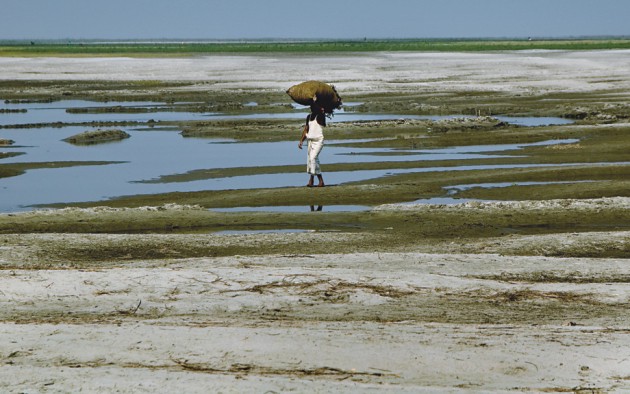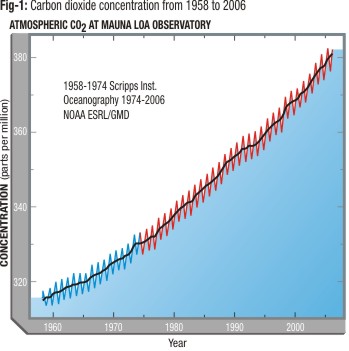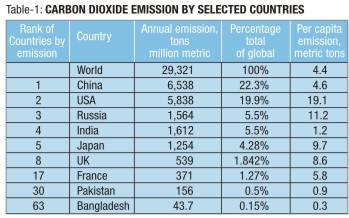
Inside
|
The Climate Change Challenge DR. ABDUL MATIN examines the causes and effects of global warming and how to counter it.
Global warming has become one of the most serious environmental problems now threatening the livelihood of millions of people and the economies of many developing countries including Bangladesh. It is believed that increases in concentrations of greenhouse gases, including carbon dioxide, in the atmosphere are responsible for global warming. Other major environmental problems affecting Bangladesh include reduced flow of water in the rivers, pollution of water, air and soil with adverse effects on agriculture, health, flora and fauna. Since about 1750, the concentrations of carbon dioxide and some other greenhouse gases have been increasing steadily. The present atmospheric concentration of carbon dioxide is about 391 ppm by volume. The increase of carbon dioxide concentration from 1958 to 20061 is shown in Fig. 1. Different scenarios project carbon dioxide concentration to increase to a range of 541-970 ppm by the year 2100.
The emissions of carbon dioxide by selected countries, based on recently available data2, are shown in Table-1. The table shows that while China tops the list in total emissions, USA has the highest per capita emission. As expected, the emission by Bangladesh is very low both in terms of total and per capita emissions due to low consumption of energy. The irony is that, with one of the lowest emission rates of greenhouse gases, Bangladesh has become one of the most vulnerable countries to global warming. Global temperatures on both land and sea have increased by 0.75 0C relative to the period 1860-1900 due to global warming. Increasing global temperatures are believed to be causing climatic changes and variations. The report of the Intergovernmental Panel on Climate Change (IPCC) published in 20073 confirms that the average temperature of the global ocean has increased. This rise of temperature causes sea water to expand, contributing to sea level rise. The glaciers are also melting in both the hemispheres, thus causing further increases in sea level. Global average sea level rose at an average rate of 1.8 mm per year from 1961 to 2003. The rate was faster during 1993 to 2003, about 3.1 mm per year. Droughts have been more intense over wider areas since 1970s. The pattern of rainfall has changed. Heavy rainfalls during off seasons and at unusual places causing severe floods have been observed. Changes in extreme temperatures have been noticed over the last 50 years. There are now more hot days and hot nights and less cold days and cold nights than before. The IPCC predicts that by the end of the 21st century, climate change will result in a probable temperature rise between 1.8°C and 4°C, with a possible temperature rise between 1.1°C and 6.4°C. The sea level rise is most likely to be 18-79 cm. As a result of the sea level rise, vast low lying coastal areas, including those in Bangladesh, may go under water with disastrous effects on agriculture, ecology and economy. It is further postulated that climate change will have significant impacts, including increased stress on water supplies and a widening threat of species extinction. Agriculture and forestry will be badly affected. Natural disasters may be more frequent and severe. New kinds of diseases may affect both human and animal health.
The United Nations Framework Convention on Climate Change5 agreed that the developed countries were mainly responsible for the largest share of historical and current global emissions of greenhouse gases. It was also agreed that the share of global emissions originating in developing countries would grow to meet their social and economic development. At the United Nations Copenhagen Conference on Climate Change6 in December 2009, the United States of America, India, Brazil, South Africa and China came to an agrement to combat global warming without any specific agenda on emissions. The agreement, however, committed the countries to keep global warming at or below 2 degrees Celsius. It also promised US$ 30 billion in funding to battle climate change by 2012. In December 2010, more than 190 countries agreed at the UN-led conference on global warming and climate change at Cancun in Mexico7 to take 'urgent action' to limit temperature rises to no more than 2 degrees Celsius (3.6 Fahrenheit) above pre-industrial levels and asked for studies on 'strengthening the commitment to 1.5 degrees Celsius'. The agreement requires wealthy countries to cut emissions by 25 to 40 percent by 2020 compared with 1990 levels. The United States of America, not being a signatory to the Kyoto Protocol, is not bound by this section of the resolution. The Cancun Conference also agreed to set up a "Green Climate Fund" to administer assistance to poor nations, which are already experiencing more floods, droughts and other climatic variations. The fund is designed to distribute 100 billion dollars per year by 2020, while European Union, Japan and the United States of America pledged 30 billion dollars as immediate assistance. Various mechanisms are available for the reduction of carbon dioxide emission8. These include increasing the efficiencies of fossil fuel fired power plants, switching power generation from fossil fuels to renewable energy sources and to nuclear energy, energy conservation and storing of carbon dioxide at major source points, development of new carbon sinks, etc. Carbon capture and storage (CCS) is a system to mitigate climate change by capturing carbon dioxide from major sources such as power plants and subsequently storing it away safely instead of releasing it into the atmosphere. Carbon sequestration is a process to remove carbon dioxide from the atmosphere. Various methods of artificially capturing and storing carbon, as well as enhancing natural sequestration processes, are being explored. The main natural process is photosynthesis by plants and single-celled organism, like algae. Probable options for natural sinks are reforestration and cultivation of algae. Being one of the most vulnerable countries, Bangladesh has been playing a vital role in all international conferences on climate change, demanding cuts in emissions of carbon dioxide and compensation for mitigation of the effects of climate change. Bangladesh Climate Change Strategy and Action Plan 20099 stipulates construction of embankments and cyclone shelters, raising the levels of roads and rail lines, development of new varieties of crops that are resistant to drought, flood and salinity, better management of irrigation water, reforestation and provision of drinking water and healthcare facilities in the affected areas. Bangladesh is likely to get substantial compensation from the proposed Green Climate Fund. We must make realistic and effective plans and build up our managerial capability for proper and transparent utilisation of all climate funds. Without such measures, all efforts for mitigation of the effects of climate change will go in vain. Bangladesh is situated at the confluence of the Ganges, Brahmaputra and Meghna rivers, forming the largest delta in the world. Alluvial soil deposited by 57 trans-boundary rivers has created one of the most fertile plains in the world with an estimated population of over 160 million. Most parts of Bangladesh are less than 12 m (39.4 ft) above seal level. Because of this unique geophysical location, Bangladesh is bestowed with a rich biological diversity. The Sundarbans, the world's largest mangrove and home to the famous royal Bengal tigers and spotted deer, is situated in the southern coastal region of Bangladesh.
Due to a high population density (~1,100 per sq. km), the pressure on both water and land has been multiplying. The flow of water in the rivers is already reduced substantially because of diversion of water for irrigation and other uses upstream in India. Most of the water bodies get dried up during the winter mainly due to irrigation. This is causing irreversible damages to both flora and fauna besides affecting navigability. Many varieties of fish and other aquatic species have already disappeared. The remaining water bodies are getting polluted due to excessive use of pesticides and chemical fertilisers in rural areas and discharge of untreated industrial and municipal wastes in urban areas. The World Conservation Union in 2000 classified 40% of Bangladesh's freshwater fish species, the major source of animal protein to the local population, as threatened with extinction. Because of shortage of surface water, both irrigation and supply of potable water have become heavily dependent on underground aquifers. Consequently, the underground water levels have gone down substantially without being recharged regularly. In many places, the underground water has been contaminated with arsenic. This has become a serious health hazard in many areas in Bangladesh. It is reported that arsenic has also entered into the human food chain, mainly the staple food rice, in some places. The water problem is likely to be more acute as more water is likely to be diverted upstream of the rivers, both in India and China. We must reduce our dependence on underground aquifers to avoid possible soil subsidence. To solve the water crisis, there is an urgent need of a mega-plan for storage and management of surface water. The pressure on land and the demand for firewood are causing large-scale deforestation in Bangladesh, particularly in the preserved areas of Sundarbans, Modhupur, Bhawal, Chittagong and other places. According to a USAID report10, "Bangladesh now has among the smallest areas of protected and intact forest in the world, consisting of 1.4% of its landmass." Steps have, however, been taken by the government to plant more trees and to reverse the process of deforestation. The unplanned disposal of solid wastes, particularly polyethylene bags, caused serious threats to the soil and the drainage systems in urban areas. There has been some improvement to this problem due to restrictions imposed by the government on the manufacture and sale of polyethylene bags. Local air pollution is observed in some urban areas and other places due to exhausts coming from automobiles, brick kilns, power plants and small diesel generators. The government enacted the Bangladesh Ecological Conservation Act 1995 "for conservation, improvement of environmental standards and control and mitigation of environmental pollution". Other major preservation laws include Bangladesh Wild Life (Preservation) Order of 1973, the Marine Fisheries Ordinance 1983, the Brick Burning (Control) Act of 1983, etc. Unfortunately, these laws are not being applied rigidly even though the government recently set up environmental courts to take legal action against pollution. Strict legal action is necessary against major industrial and municipal polluters and violators of the preservation laws. Legal action alone is not, however, enough for conservation of the environment and preservation of wild life, flora and fauna. What is more important is the creation of public awareness. For conservation of the environment, there should be more dissemination of information through the news and electronic media. Mass awareness is essential to reduce degradation of the environment. Environmental science should be taught at all schools and colleges as a compulsory subject. Efforts must continue more vigorously to control the population growth which is the root cause of environmental degradation. We must remember that we have only one country and one planet. We must conserve the environment to save our country and the planet. The survival of humanity will depend on how we treat the environment. ******** 1 Wikipedia: Image: CO2-Mauna-Loa.png by Robert A. Rohde from NOAA ESRL Data ******** Dr. Abdul Matin is a former Chief Engineer of Bangladesh Atomic Energy Commission. |


 To reduce the emission of greenhouse gases, the Kyoto Protocol4 was signed on December 11, 1997 and it entered into force on February 16, 2005. According to this protocol, the industrialised countries are due to reduce their collective emissions of greenhouse gases by 5.2% compared to the year 1990.
To reduce the emission of greenhouse gases, the Kyoto Protocol4 was signed on December 11, 1997 and it entered into force on February 16, 2005. According to this protocol, the industrialised countries are due to reduce their collective emissions of greenhouse gases by 5.2% compared to the year 1990.